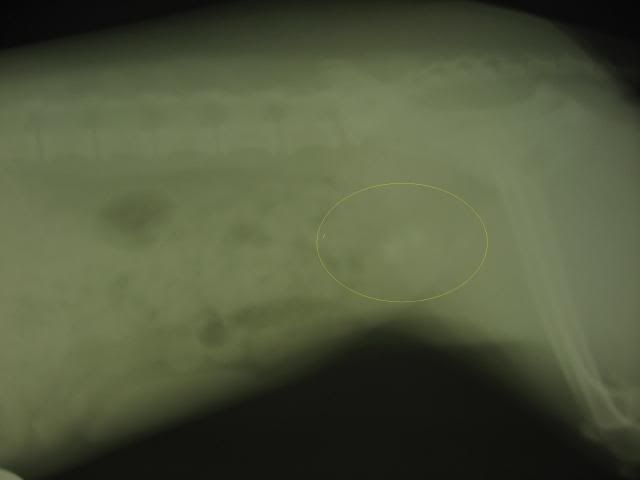Mary asks a good question...
If I have barbecue, is it safe to allow my dog to eat the bones afterward?
The quick answer is "nope, definitely not". Here's the long answer. Bones in general are not good for dogs. Yes, that may be a surprise to many people, as it's the traditional thing we give dogs and you can even buy them in pet stores. But just because it's "always been done" or "my parents did it" doesn't mean it's right. It was common for many centuries for doctors to bleed their patients, believing that doing so helped fix any imbalances in their bodies. This was the height of medical knowledge, yet it resulted in some people's death (including George Washington), and never really helped. Fifty years ago scientists just described the structure of DNA. Current medical knowledge is always changing.
There are a number of bad things about bones in general and barbecue in specific. Bones have a chance of splintering, which can cause severe irritation to the stomach and intestines when swallowed. Many types of bones are harder than teeth, and it's possible to fracture teeth while chewing on bones (I've seen it happen many times). I've also seen situations where small pieces of bone have mixed with a dog's feces, creating a sort of cement-like substance that has caused constipation and even intestinal impaction. Yes, dogs like bones, and yes, chewing on hard substances like this will help keep tartar off teeth. However, I believe that the risks far outweigh the benefits.
Barbecue is very bad for dogs. It is rich and fatty, which can at a minimum cause diarrhea, vomiting, or even just an upset GI tract. In more severe situations (usually when a lot of fatty food is eaten, or the dog is small) it can cause an inflammation of the pancreas called pancreatitis. Pancreatitis can be life-threatening, and often requires hospitalizaiton and intense treatment. No, it's not going to happen every time, and I know there are plenty of people who will read this and think of plenty of times their dog has eaten things like this and been fine. I can't really argue with that. But as a doctor I have seen many, many situations where it hasn't been fine, and the pet has needed medication or hospitalization. Is it worth it to you to risk it in your pet?
Lastly, please remember that dogs don't have any innate sense or instinct for what is best for them. They're like a 3 year-old child, and react to merely what makes them happy. When it comes to food, they simply like what tastes best, not what's healthiest for them. I'm sure you wouldn't let your toddler go into the kitchen and eat whatever they wanted. Have the same attitude towards your dog.
If I have barbecue, is it safe to allow my dog to eat the bones afterward?
The quick answer is "nope, definitely not". Here's the long answer. Bones in general are not good for dogs. Yes, that may be a surprise to many people, as it's the traditional thing we give dogs and you can even buy them in pet stores. But just because it's "always been done" or "my parents did it" doesn't mean it's right. It was common for many centuries for doctors to bleed their patients, believing that doing so helped fix any imbalances in their bodies. This was the height of medical knowledge, yet it resulted in some people's death (including George Washington), and never really helped. Fifty years ago scientists just described the structure of DNA. Current medical knowledge is always changing.
There are a number of bad things about bones in general and barbecue in specific. Bones have a chance of splintering, which can cause severe irritation to the stomach and intestines when swallowed. Many types of bones are harder than teeth, and it's possible to fracture teeth while chewing on bones (I've seen it happen many times). I've also seen situations where small pieces of bone have mixed with a dog's feces, creating a sort of cement-like substance that has caused constipation and even intestinal impaction. Yes, dogs like bones, and yes, chewing on hard substances like this will help keep tartar off teeth. However, I believe that the risks far outweigh the benefits.
Barbecue is very bad for dogs. It is rich and fatty, which can at a minimum cause diarrhea, vomiting, or even just an upset GI tract. In more severe situations (usually when a lot of fatty food is eaten, or the dog is small) it can cause an inflammation of the pancreas called pancreatitis. Pancreatitis can be life-threatening, and often requires hospitalizaiton and intense treatment. No, it's not going to happen every time, and I know there are plenty of people who will read this and think of plenty of times their dog has eaten things like this and been fine. I can't really argue with that. But as a doctor I have seen many, many situations where it hasn't been fine, and the pet has needed medication or hospitalization. Is it worth it to you to risk it in your pet?
Lastly, please remember that dogs don't have any innate sense or instinct for what is best for them. They're like a 3 year-old child, and react to merely what makes them happy. When it comes to food, they simply like what tastes best, not what's healthiest for them. I'm sure you wouldn't let your toddler go into the kitchen and eat whatever they wanted. Have the same attitude towards your dog.











